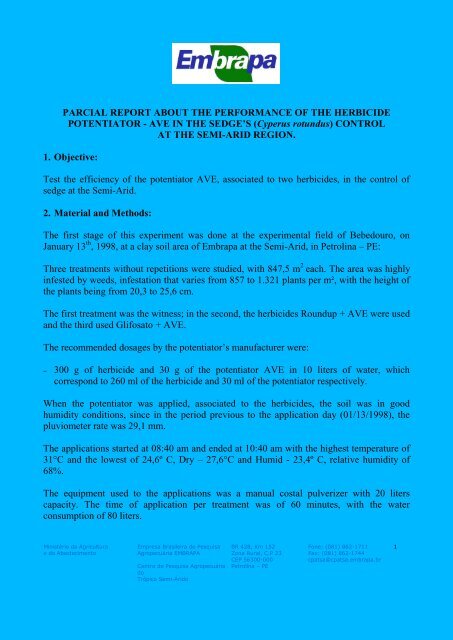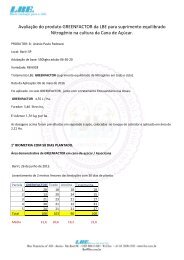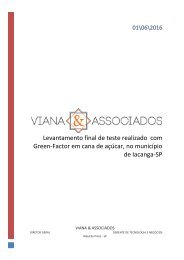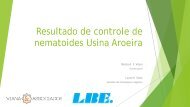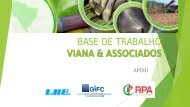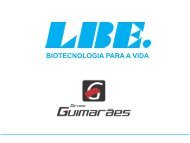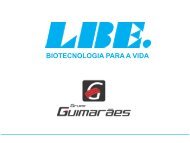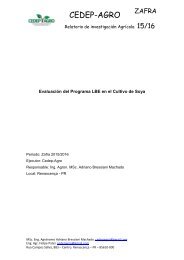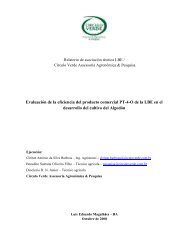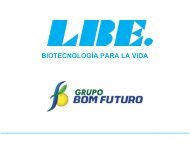Ave no controle da Tiririca em Inglês (2)
You also want an ePaper? Increase the reach of your titles
YUMPU automatically turns print PDFs into web optimized ePapers that Google loves.
PARCIAL REPORT ABOUT THE PERFORMANCE OF THE HERBICIDE<br />
POTENTIATOR - AVE IN THE SEDGE’S (Cyperus rotundus) CONTROL<br />
AT THE SEMI-ARID REGION.<br />
1. Objective:<br />
Test the efficiency of the potentiator AVE, associated to two herbicides, in the control of<br />
sedge at the S<strong>em</strong>i-Arid.<br />
2. Material and Methods:<br />
The first stage of this experiment was done at the experimental field of Bebedouro, on<br />
January 13 th , 1998, at a clay soil area of Embrapa at the S<strong>em</strong>i-Arid, in Petrolina – PE:<br />
Three treatments without repetitions were studied, with 847,5 m 2 each. The area was highly<br />
infested by weeds, infestation that varies from 857 to 1.321 plants per m², with the height of<br />
the plants being from 20,3 to 25,6 cm.<br />
The first treatment was the witness; in the second, the herbicides Roundup + AVE were used<br />
and the third used Glifosato + AVE.<br />
The recommended dosages by the potentiator’s manufacturer were:<br />
– 300 g of herbicide and 30 g of the potentiator AVE in 10 liters of water, which<br />
correspond to 260 ml of the herbicide and 30 ml of the potentiator respectively.<br />
When the potentiator was applied, associated to the herbicides, the soil was in good<br />
humidity conditions, since in the period previous to the application <strong>da</strong>y (01/13/1998), the<br />
pluviometer rate was 29,1 mm.<br />
The applications started at 08:40 am and ended at 10:40 am with the highest t<strong>em</strong>perature of<br />
31°C and the lowest of 24,6º C, Dry – 27,6°C and Humid - 23,4º C, relative humidity of<br />
68%.<br />
The equipment used to the applications was a manual costal pulverizer with 20 liters<br />
capacity. The time of application per treatment was of 60 minutes, with the water<br />
consumption of 80 liters.<br />
Ministério <strong>da</strong> Agricultura<br />
e do Abastecimento<br />
Empresa Brasileira de Pesquisa<br />
Agropecuária EMBRAPA<br />
Centro de Pesquisa Agropecuária<br />
do<br />
Trópico S<strong>em</strong>i-Árido<br />
BR 428, Km 152<br />
Zona Rural, C.P 23<br />
CEP 56300-000<br />
Petrolina – PE<br />
Fone: (081) 862-1711<br />
Fax: (081) 862-1744<br />
cpatsa@cpatsa.<strong>em</strong>brapa.br<br />
1
3. Results:<br />
The partial results obtained may be consider as extr<strong>em</strong>ely good, considering the following<br />
aspects:<br />
3.1 95% of the sedge plants that were in the parcels when the product was applied<br />
were completely dead after 20 <strong>da</strong>ys.<br />
3.2 That affirmation was understood when, soon after the application many sedge<br />
plants that stood up from each treatment were isolated to observe a future sprouting that<br />
did <strong>no</strong>t happen, although there were 124 mm of rain in the period of 12 <strong>da</strong>ys from the<br />
first <strong>da</strong>y of the applications (01/14/1998).<br />
3.3 The 5% of the sedge plants were <strong>no</strong>t eliminate due to the following:<br />
a. The depth in which some rhizome were was from 13 to 42 cm, and they had <strong>no</strong>t <strong>em</strong>erged<br />
when the products application was done.<br />
b. The density and height of the existent weeds in the area (more than seven different<br />
species were cataloged) probably prevented the products to reach some sedge plants that<br />
were below th<strong>em</strong>.<br />
Apparently, there were <strong>no</strong> significant differences in relation to the number of dead sedge<br />
plants, when the Roundup was compared to the Gliphosphate.<br />
Compl<strong>em</strong>entary studies must be done to determine other parameters, such as: appropriate<br />
quantity of the herbicide to be applied, period of application and eco<strong>no</strong>mic analysis.<br />
The compl<strong>em</strong>ental studies, programmed to the second stage of this study, were already<br />
started, and they aim mainly to determine the adequate quantity of the herbicide, in<br />
eco<strong>no</strong>mic terms, since it was observed that in the first stage, probably due to the high<br />
quantity used (520 ml of herbicide to 20 liters of water), some cultures sowed in the area, 50<br />
<strong>da</strong>ys after the application showed a small germination percentage, which varied from 50 to<br />
75% that is considered technically <strong>no</strong>n satisfactory to experimental areas.<br />
Ministério <strong>da</strong> Agricultura<br />
e do Abastecimento<br />
Empresa Brasileira de Pesquisa<br />
Agropecuária EMBRAPA<br />
Centro de Pesquisa Agropecuária<br />
do<br />
Trópico S<strong>em</strong>i-Árido<br />
BR 428, Km 152<br />
Zona Rural, C.P 23<br />
CEP 56300-000<br />
Petrolina – PE<br />
Fone: (081) 862-1711<br />
Fax: (081) 862-1744<br />
cpatsa@cpatsa.<strong>em</strong>brapa.br<br />
2
4. Conclusions:<br />
– O potentiator AVE, associated to a syst<strong>em</strong>ic herbicide, eliminates the sedge plants since a<br />
very uniform pulverization is done, in a way that all the foliar area of the plant is reached.<br />
– The use of the AVE potentiator, associated to a syst<strong>em</strong>ic herbicide, in the sedge control<br />
may reduce the costs of this control, since it reduces considerably the number of<br />
applications of the herbicide from four (manufacturer’s recommen<strong>da</strong>tions) to at the<br />
maximum two.<br />
Petrolina, 19th of May 1998.<br />
Ministério <strong>da</strong> Agricultura<br />
e do Abastecimento<br />
Empresa Brasileira de Pesquisa<br />
Agropecuária EMBRAPA<br />
Centro de Pesquisa Agropecuária<br />
do<br />
Trópico S<strong>em</strong>i-Árido<br />
BR 428, Km 152<br />
Zona Rural, C.P 23<br />
CEP 56300-000<br />
Petrolina – PE<br />
Fone: (081) 862-1711<br />
Fax: (081) 862-1744<br />
cpatsa@cpatsa.<strong>em</strong>brapa.br<br />
3
FINAL TECHNICAL REPORT ABOUT THE PERFORMANCE OF THE AVE<br />
POTENTIATOR AT THE SEMI-ARID, IN THE SEDGE (Cyperus rotundus L.)<br />
CONTROL<br />
1. Objective<br />
Test the efficiency of the AVE potentiator, associated to two herbicides, in the sedge control<br />
at the S<strong>em</strong>i-Arid region.<br />
2. Material and Methods:<br />
The second stage of this work was done at the Experimental Field of Bebedouro as well,<br />
which belongs to EMBRAPA S<strong>em</strong>i-Arid, at the municipal district of Petrolina, PE, at a Clay<br />
soil, without any cultivation, and that presented a sedge infestation percentage around 95%<br />
(visual evaluation), in which the population had in average 227 plants/m². In this area 12<br />
different species of weeds were cataloged).<br />
The experiment outlining was of random blocks, with five treatments of 400 m² and three<br />
repetitions of 2.000 m² each, being used as control el<strong>em</strong>ent, the Roundup herbicide. The<br />
quantities of the herbicide applied in each treatment were of: 50; 75; 100; 125 and 150 ml,<br />
associated to 60ml of the AVE Potentiator.<br />
The evaluations were done by sinecological methods (plants counting), in areas of 1 m², in<br />
all treatments and repetitions.<br />
The experiment had duration of 150 <strong>da</strong>ys (May/Sept<strong>em</strong>ber 98), in the period were done four<br />
evaluations and two applications through foliar pulverization. The applications were done<br />
with costal pulverizer, with the pressure and medium outflow of 2,22 kg/cm 2 e 2,21<br />
l/minute, respectively<br />
The evaluations and the pulverizations were done at the following order:<br />
– First evaluation on May 12th, before the first application;<br />
– First application on May 13th, being the sedge with medium number and height per leaf<br />
varying from 8 to 12 and from 16 to 25 cm, respectively;<br />
Ministério <strong>da</strong> Agricultura<br />
e do Abastecimento<br />
Empresa Brasileira de Pesquisa<br />
Agropecuária EMBRAPA<br />
Centro de Pesquisa Agropecuária<br />
do<br />
Trópico S<strong>em</strong>i-Árido<br />
BR 428, Km 152<br />
Zona Rural, C.P 23<br />
CEP 56300-000<br />
Petrolina – PE<br />
Fone: (081) 862-1711<br />
Fax: (081) 862-1744<br />
cpatsa@cpatsa.<strong>em</strong>brapa.br<br />
4
– Second evaluation on June 3rd, 21 <strong>da</strong>ys after the first application, being determined by<br />
treatment and in all repetitions, the percentage of dead plants and survivors;<br />
– Third evaluation on July 29 th , 77 <strong>da</strong>ys after the first application, with the same objectives<br />
of the second, and including the <strong>em</strong>erged plants as well (new plants);<br />
– Second application on July 30 th ;<br />
– Fourth evaluation on Sept<strong>em</strong>ber 2nd, 34 <strong>da</strong>ys after the second application, with similar<br />
objectives from the third.<br />
3. Results and Discussion:<br />
1 – The percentage of dead sedge plants, 21 <strong>da</strong>ys after the first application, vary from 31%<br />
(50ml) to 89% (150ml) respectively.<br />
2 – The medium percentage of survivor plants at the same period vary from 69% (50 ml) to<br />
11% (150 ml), being the main cause of the plants surviving, the <strong>no</strong>n direct contact with the<br />
applied products, since they were below other bigger weeds.<br />
3 – The medium percentage of dead sedge plants, after 34 <strong>da</strong>ys from the second application,<br />
vary from 93% (50 ml) to 99% (150 ml).<br />
4 – The medium percentage of the survivor plants in the same period, has also vary from 7%<br />
(50 ml) to 0,98% (150 ml), so that in this second application, the treatment 4 (125 ml<br />
Roundup + 60 ml AVE) have presented 100 % of dead plants.<br />
Ministério <strong>da</strong> Agricultura<br />
e do Abastecimento<br />
Empresa Brasileira de Pesquisa<br />
Agropecuária EMBRAPA<br />
Centro de Pesquisa Agropecuária<br />
do<br />
Trópico S<strong>em</strong>i-Árido<br />
BR 428, Km 152<br />
Zona Rural, C.P 23<br />
CEP 56300-000<br />
Petrolina – PE<br />
Fone: (081) 862-1711<br />
Fax: (081) 862-1744<br />
cpatsa@cpatsa.<strong>em</strong>brapa.br<br />
5
4. Conclusions:<br />
– The AVE potentiator associated to the Roundup herbicide, has shown to be efficient at<br />
the sedge (Cyperus rotundus L.), control, mainly with the higher dosages;<br />
– There were <strong>no</strong> significant changes between the treatments 4 and 5 (125 and 150 ml),<br />
respectively;<br />
– This efficiency becomes higher after the second application.<br />
Petrolina, Nov<strong>em</strong>ber 16th, 1999.<br />
Ministério <strong>da</strong> Agricultura<br />
e do Abastecimento<br />
Empresa Brasileira de Pesquisa<br />
Agropecuária EMBRAPA<br />
Centro de Pesquisa Agropecuária<br />
do<br />
Trópico S<strong>em</strong>i-Árido<br />
BR 428, Km 152<br />
Zona Rural, C.P 23<br />
CEP 56300-000<br />
Petrolina – PE<br />
Fone: (081) 862-1711<br />
Fax: (081) 862-1744<br />
cpatsa@cpatsa.<strong>em</strong>brapa.br<br />
6
TREATED SEDGE<br />
RHIZOME<br />
WITNESS SEDGE<br />
Ministério <strong>da</strong> Agricultura<br />
e do Abastecimento<br />
Empresa Brasileira de Pesquisa<br />
Agropecuária EMBRAPA<br />
Centro de Pesquisa Agropecuária<br />
do<br />
Trópico S<strong>em</strong>i-Árido<br />
BR 428, Km 152<br />
Zona Rural, C.P 23<br />
CEP 56300-000<br />
Petrolina – PE<br />
Fone: (081) 862-1711<br />
Fax: (081) 862-1744<br />
cpatsa@cpatsa.<strong>em</strong>brapa.br<br />
7
Ministério <strong>da</strong> Agricultura<br />
e do Abastecimento<br />
Empresa Brasileira de Pesquisa<br />
Agropecuária EMBRAPA<br />
Centro de Pesquisa Agropecuária<br />
do<br />
Trópico S<strong>em</strong>i-Árido<br />
BR 428, Km 152<br />
Zona Rural, C.P 23<br />
CEP 56300-000<br />
Petrolina – PE<br />
Fone: (081) 862-1711<br />
Fax: (081) 862-1744<br />
cpatsa@cpatsa.<strong>em</strong>brapa.br<br />
8
Ministério <strong>da</strong> Agricultura<br />
e do Abastecimento<br />
Empresa Brasileira de Pesquisa<br />
Agropecuária EMBRAPA<br />
Centro de Pesquisa Agropecuária<br />
do<br />
Trópico S<strong>em</strong>i-Árido<br />
BR 428, Km 152<br />
Zona Rural, C.P 23<br />
CEP 56300-000<br />
Petrolina – PE<br />
Fone: (081) 862-1711<br />
Fax: (081) 862-1744<br />
cpatsa@cpatsa.<strong>em</strong>brapa.br<br />
9
Ministério <strong>da</strong> Agricultura<br />
e do Abastecimento<br />
Empresa Brasileira de Pesquisa<br />
Agropecuária EMBRAPA<br />
Centro de Pesquisa Agropecuária<br />
do<br />
Trópico S<strong>em</strong>i-Árido<br />
BR 428, Km 152<br />
Zona Rural, C.P 23<br />
CEP 56300-000<br />
Petrolina – PE<br />
Fone: (081) 862-1711<br />
Fax: (081) 862-1744<br />
cpatsa@cpatsa.<strong>em</strong>brapa.br<br />
10
Ministério <strong>da</strong> Agricultura<br />
e do Abastecimento<br />
Empresa Brasileira de Pesquisa<br />
Agropecuária EMBRAPA<br />
Centro de Pesquisa Agropecuária<br />
do<br />
Trópico S<strong>em</strong>i-Árido<br />
BR 428, Km 152<br />
Zona Rural, C.P 23<br />
CEP 56300-000<br />
Petrolina – PE<br />
Fone: (081) 862-1711<br />
Fax: (081) 862-1744<br />
cpatsa@cpatsa.<strong>em</strong>brapa.br<br />
11
Ministério <strong>da</strong> Agricultura<br />
e do Abastecimento<br />
Empresa Brasileira de Pesquisa<br />
Agropecuária EMBRAPA<br />
Centro de Pesquisa Agropecuária<br />
do<br />
Trópico S<strong>em</strong>i-Árido<br />
BR 428, Km 152<br />
Zona Rural, C.P 23<br />
CEP 56300-000<br />
Petrolina – PE<br />
Fone: (081) 862-1711<br />
Fax: (081) 862-1744<br />
cpatsa@cpatsa.<strong>em</strong>brapa.br<br />
12
Ministério <strong>da</strong> Agricultura<br />
e do Abastecimento<br />
Empresa Brasileira de Pesquisa<br />
Agropecuária EMBRAPA<br />
Centro de Pesquisa Agropecuária<br />
do<br />
Trópico S<strong>em</strong>i-Árido<br />
BR 428, Km 152<br />
Zona Rural, C.P 23<br />
CEP 56300-000<br />
Petrolina – PE<br />
Fone: (081) 862-1711<br />
Fax: (081) 862-1744<br />
cpatsa@cpatsa.<strong>em</strong>brapa.br<br />
13
Ministério <strong>da</strong> Agricultura<br />
e do Abastecimento<br />
Empresa Brasileira de Pesquisa<br />
Agropecuária EMBRAPA<br />
Centro de Pesquisa Agropecuária<br />
do<br />
Trópico S<strong>em</strong>i-Árido<br />
BR 428, Km 152<br />
Zona Rural, C.P 23<br />
CEP 56300-000<br />
Petrolina – PE<br />
Fone: (081) 862-1711<br />
Fax: (081) 862-1744<br />
cpatsa@cpatsa.<strong>em</strong>brapa.br<br />
14


